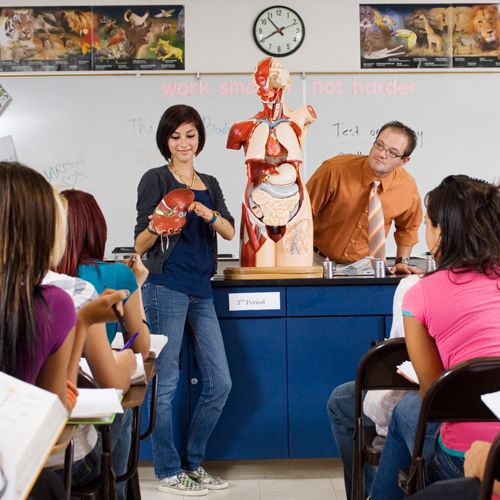My Cart
Your Shopping Cart is currently empty. Use Quick Order or Search to quickly add items to your order!
 Cara Johnson
Cara Johnson
Anatomy and Physiology Teacher, Allen High School
Allen, TX
A flipped-mastery class gives students the opportunity to drive their education. As the teacher, you provide students with a set of objectives and several activities to help guide and enhance their understanding of the material. You also conduct mini-assessments to determine what they have and have not yet mastered. The mini-assessments provide opportunities to reteach and ensure full mastery of a curriculum. By allowing students to work individually—at their own pace and using methods that work best for them—they can each take ownership of their unique learning experiences.
In my flipped-mastery anatomy and physiology class, students perform multiple dissections to bridge the gap between pictures on paper and the actual structures in a specimen. I use dissection as a valuable tool to facilitate better understanding of human anatomy, and I’ve found dissections to be most effective when performed within a flipped-mastery environment.
In years past, when I was not using flipped-mastery, I would schedule a day to dissect, and all students would dissect on that day. Of course, some students would forget to wear closed-toe shoes, and some would be in their cheerleading uniforms and not want to get them messy. And then of course there were absent students and students who weren’t feeling well. Despite these factors, I still chose the day that worked best for me and forced all present students to dissect. Unfortunately, this approach did not work as well as I had hoped. A handful of students were excited to see the specimen, but many did not see the value in performing the dissection. There were always students (too many in my opinion) who spent these class days complaining about the smell or the look of the specimen instead of actually learning the anatomy.
Now, within my flipped-mastery class, I schedule the first dissection, which we perform together. I want to provide students with direct instruction regarding where the supplies are located, how to make incisions, and how to follow the rules and guidelines outlined in the pre-lab video. After the initial dissection, students are expected to schedule with their group mates when they will perform their seven remaining dissections.
Because flipped-mastery learning is so individualized, students are often at different points within the curriculum. This presents a challenge when labs involve expensive supplies, requiring students to work together as a group. Despite this challenge, my students are expected to participate in 8 dissections throughout the year.
When students are asked to schedule dissections based on their learning, it’s interesting to hear their conversations. Some groups approach dissections as an inquiry-based lesson. They enjoy doing the dissections first and exploring what organs and structures they will be learning about in the upcoming unit. Other students are forced to plan out which day would be best to dissect with regard to where their group members are in the curriculum. And others prefer to plan their dissection days around their outfits for that week! Regardless of how they choose to dissect, they’re more engaged and willing to learn on their designated dissection day because they schedule it on their terms instead of mine.
Transitioning to a flipped-mastery anatomy and physiology class changed the way my students view dissection. Rather than reacting with “Eww,” “Gross, what is that?” or “Yuck, it smells,” students ask questions that show they’re making connections between the specimen and their own bodies. They’re seeing the value in dissection, and that’s exciting! The flipped-mastery approach to dissection also forces students to improve their time management skills. Because students depend on their group members to complete the pre-lab assignments prior to dissection, they have to be aware of how they spend their time and must use it wisely.
Dissection labs facilitate learning, and as such, they are extremely effective when performed within a mastery-based classroom. They allow students to discuss the curriculum, see the value in what they’re learning, and take ownership of their learning by actively planning it with others. When they do this, the stage is set for an authentic and valuable learning experience.